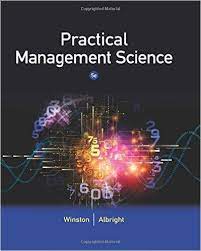Description
Test Bank For Practical Management Science 5 Edition Wayne L Winston S Christian Albright
Chapter 3 – Introduction to Optimization Modeling
1. In an optimization model, there can only be one:
a. decision variable
b. constraint
c. objective function
d. shadow price
ANSWER: c
POINTS: 1
2. In using Excel to solve linear programming problems, the changing cells represent the:
a. value of the objective function
b. constraints
c. decision variables
d. total cost of the model
ANSWER: c
POINTS: 1
3. The condition of nonnegativity requires that:
a. the objective function cannot be less that zero
b. the decision variables cannot be less than zero
c. the right hand side of the constraints cannot be greater then zero
d. the reduced cost cannot be less than zero
ANSWER: b
POINTS: 1
4. If a manufacturing process takes 4 hours per unit of x and 2 hours per unit of y and a maximum of 100 hours of manufacturing process time are available, then an algebraic formulation of this constraint is:
a. 4x + 2y≥ 100
b. 4x− 2y≤ 100
c. 4x + 2y≤ 100
d. 4x− 2y≥ 100
ANSWER: c
POINTS: 1
5. The feasible region in all linear programming problems is bounded by:
a. corner points
b. hyperplanes
c. an objective line
d. all of these options
ANSWER: b
POINTS: 1
6. Suppose a company sells two different products, x and y, for net profits of $6 per unit and $3 per unit, respectively. The slope of the line representing the objective function is:
a. 0.5
b. −0.5
c. 2
d. −2
ANSWER: d
POINTS: 1
7. The equation of the line representing the constraint 4x + 2y≤ 100 passes through the points:
a. (25,0) and (0,50)
b. (0,25) and (50,0)
c. (−25,0) and (0,−50)
d. (0,−25) and (−50,0)
ANSWER: a
POINTS: 1
8. When the profit increases with a unit increase in a resource, this change in profit will be shown in Solver’s sensitivity report as the:
a. add-in price
b. sensitivity price
c. shadow price
d. additional profit
ANSWER: c
POINTS: 1
9. Linear programming models have three important properties. They are:
a. optimality, additivity and sensitivity
b. optimality, linearity and divisibility
c. divisibility, linearity and nonnegativity
d. proportionality, additivity and divisibility
ANSWER: d
POINTS: 1
10. Consider the following linear programming problem:
Maximize 4x1 + 2y2
Subject to:
4x1 + 2y2≤ 40
2x1 + y2≥ 20
x1, y2≥ 0
The above linear programming problem:
a. has only one feasible solution
b. has more than one optimal solution
c. exhibits infeasibility
d. exhibits unboundedness
ANSWER: c
POINTS: 1
11. All linear programming problems should have a unique solution, if they can be solved.
a. True
b. False
ANSWER: False
POINTS: 1
12. When formulating a linear programming spreadsheet model, there is a set of designated cells that play the role of the decision variables. These are called the changing cells.
a. True
b. False
ANSWER: True
POINTS: 1
13. The feasible region in a graphical solution of a linear programming problem will appear as some type of polygon, with lines forming all sides.
a. True
b. False
ANSWER: True
POINTS: 1
14. If the objective function has the equation {4x + 2y}, then the slope of the objective function line is −2.
a. True
b. False
ANSWER: True
POINTS: 1
15. If a constraint has the equation 5x + 2y≤ 60, then the constraint line passes through the points (0,12) and (30,0).
a. True
b. False
ANSWER: False
POINTS: 1
16. Shadow prices are associated with nonbinding constraints, and show the change in the optimal objective function value when the right side of the constraint equation changes by one unit.
a. True
b. False
ANSWER: False
POINTS: 1
17. Suppose the allowable increase and decrease for an objective coefficient of a decision variable that has a current value of $50 are $25 (increase) and $10 (decrease). If the coefficient were to change from $50 to $65, the optimal value of the objective function would not change.
a. True
b. False
ANSWER: False
POINTS: 1
18. Suppose the allowable increase and decrease for shadow price for a constraint are $25 (increase) and $10 (decrease). If the right hand side of that constraint were to increase by $10 the optimal solution would not change.
a. True
b. False
ANSWER: False
POINTS: 1
19. The proportionality property of LP models implies that the sum of the contributions from the various activities to a particular constraint equals the total contribution to that constraint.
a. True
b. False
ANSWER: True
POINTS: 1
20. Common errors in LP models that exhibit unboundedness are a constraint that has been omitted or an input which is incorrect.
a. True
b. False
ANSWER: True
POINTS: 1
Exhibit 3-1
A winemaker in California’s Napa Valley must decide how much of two types of wine she will produce from a particular variety of grapes. Each liter of table wine yields $8 profit, while each liter of desert wine produces $3 profit. The labor hours and bottling process time used for type of wine are given in the table below. Resources available include 200 labor hours and 80 hours of bottling process time. Assume the winemaker has more than enough grapes available to supply any feasible production plan.
Table Desert
Labor (Hours) 0.20 0.60
Process Time (Hours) 0.30 0.10


Be the first to review “Test Bank For Practical Management Science 5 Edition Wayne L Winston S Christian Albright”